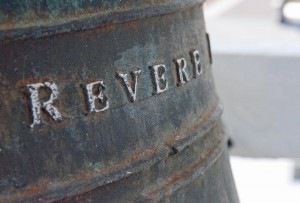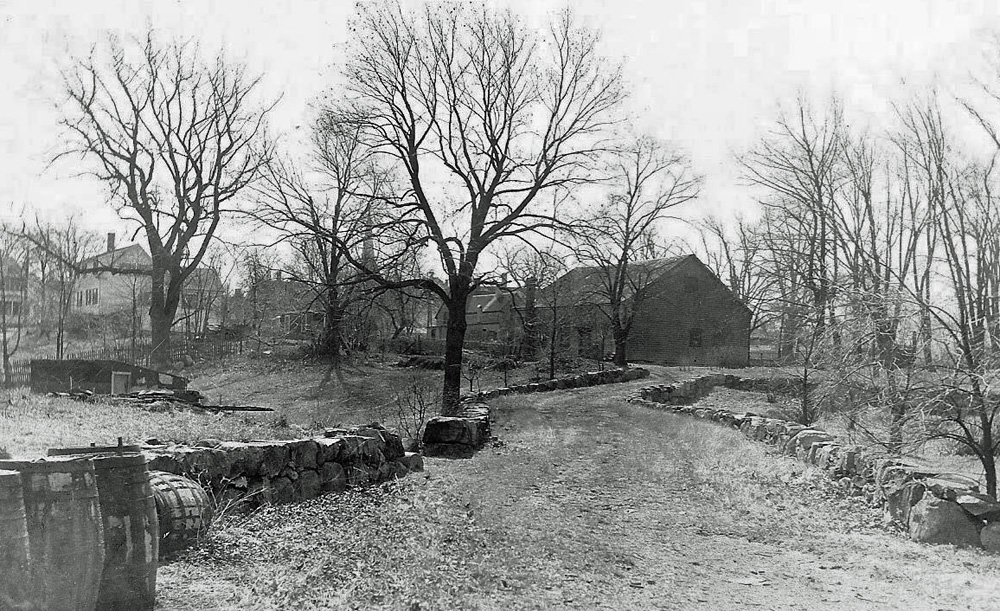True Tales from Canton’s Past: Paul Revere bells
By George T. ComeauThrough the trees and across the Canton Corner Cemetery, the bell peals each Sunday. The sweet sound calls parishioners to the services at the First Parish Unitarian Universalist Church — the quintessential white steeple church alongside the burying ground where generations of Canton’s citizens have been laid to rest.

A detail of the bell hanging in the belfry at the Unitarian Universalist Church at Canton Corner (photo by George T. Comeau)
And from this steeple, history sounds forth. For close to 190 years the bell that greets the ears of Canton’s townspeople is that of Paul Revere & Son, Boston. Actually, in this case, Canton. Few people realize that among the many accomplishments of Paul Revere, we can add casting bells to his legacy. Long recognized as an expert silversmith, Revere was at the core of his craft a “founder.” As an expert in metallurgy, he is known for creating fine engravings, museum-quality sterling silver, and of course, as the father of the copper industry in America.
Paul Revere, as master craftsman, hardly saw a task that he could not undertake. It is said that he derived great satisfaction from perfection. The task of casting a bell is extremely difficult, and in colonial America most of the bells that hung in church steeples were imported from England. In 1792 the bell in the tower of the Second Church of Boston cracked and was rendered unusable. So fragile was the bell that it would only be rung in case of fire. Revere, a member of the congregation, met with other church elders to decide what should be done. A subscription was raised to either recast the bell in America or send it to England. Revere pledged to recast the bell, despite the fact that he had never actually cast a bell in his life.
This is the characteristic of the man — to boldly pronounce his intention of learning an entirely new craft. Revere consulted with Colonel Aaron Hobart in Abington, who had been casting bells for years. Traveling to the small foundry, Revere persuaded one of Hobart’s sons to come back to Boston and help him recast the broken bell. The ambitious project was not quite a success. The new bell sounded “panny, harsh and shrill.” It was placed in the belfry and Bostonians heeded its call for years. Eventually this bell was sold to Saint James Church in Cambridge; having no bell tower, they placed it in the nave of the church where it sits silent today.
No matter the inferior sound, the first bell cast in Boston would earn the 62-year-old patriot a new job, that of casting bells. It would be Revere’s intent to make a bell for every steeple in in New England. And with his son, Joseph Warren Revere, he would make good on his mission.
The authority on Paul Revere’s bells is now 91 years old. Edward Stickney lives with his wife in an assisted living community in Woburn. Stickney worked in the Optical Research Laboratory at Boston University in 1946, and eventually his lab would spin off and become a military contractor that developed the cameras and optics for U2 spy planes and Apollo space missions. For 37 years, Stickney was a “mechanical optical designer,” but he and his wife’s real passion was chasing Paul Revere’s bells.
“Evelyn would do the writeups and type my notes,” said Stickney, “and I would climb the steeples. She only climbed one steeple, never did it again.” On a recent phone call, Stickney rattled off the facts about Revere bells. The years dropped back as he explained his hunt beginning in Falmouth in 1950.
“We were taking pictures of that church on Cape Cod,” he recalled, “and the minister came out and asked if I wanted to take a shot of their Revere bell — I had no idea that Paul Revere cast bells.”
And with that single bell, the Stickney’s would become the authorities on the subject.
In all, there were more than 969 bells cast between 1792 and 1828. By 1804, Revere moved his bell foundry to Canton to coincide with his ongoing work at the Revere Copper and Rolling Mill. In Canton, Revere had more space to work, and he erected a bell tower in which to hang the newly cast instruments. In many cases a bell would fail if it were hung improperly.

The Bell Foundry looking toward Neponset Street, from the Revere Copper Rolling Mill (Courtesy of the Canton Historical Society)
In the English style, the bell is meant to be rung by a wheel, and improper striking could crack the bell. Due to the addition of tin to the copper, bells are especially susceptible to cracking in winter. A cracked bell cannot be repaired; it must be recast, and Revere did a considerable business recasting church bells. Paul Revere himself was responsible for a few hundred bells, and in 1811 he ended his active role, turning over the business to his son.
Joseph Warren Revere’s house still stands on Neponset Street, and not far from the house was the bell foundry. The small building was actually no more than a barn. Photographs in the mid 1960s show a small, low, wooden structure just past Plymouth Street, quite near the intersection across from Cape Cod Lane. This was all part of the Revere & Son property, and the company stock list showed that nearly 400 bells were cast by Paul & Joseph Revere. The bell foundry was demolished after 1965.
(Click on page 2 below to continue reading)
Page 1 Page 2
Short URL: https://www.thecantoncitizen.com/?p=12305










